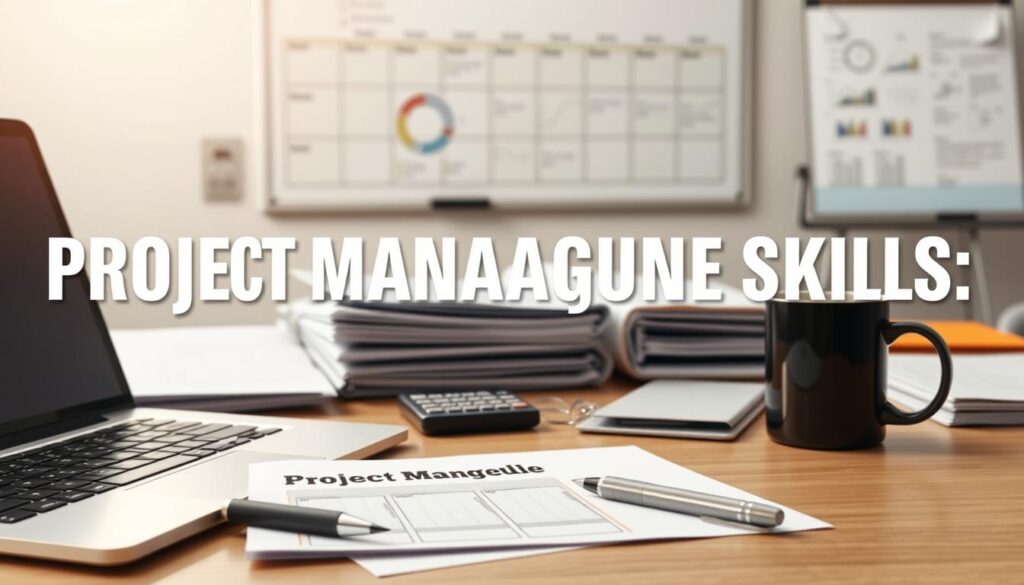Effective project management is the backbone of any successful endeavor. As Scott Berkun aptly puts it, “A project manager is like a doctor who leads the trauma team and decides the course of action for a patient – both at the same time.” This analogy underscores the crucial role of a project manager in navigating complex projects and making informed decisions.
A successful project manager must possess a unique blend of skills, including adaptability, communication, and conflict resolution. According to experts, a project manager’s key responsibilities include coordinating stakeholders and managing resources, as well as developing a clear project plan and mitigating potential risks.
Key Takeaways
- Project managers must possess a unique blend of skills, including adaptability and communication.
- Coordinating stakeholders and managing resources is crucial for project success.
- A clear project plan is necessary for successful project execution.
- Risk management is vital to mitigate potential issues.
- Effective project planning is essential for achieving project goals.
Understanding the Role of a Project Manager
Understanding the role of a project manager is essential to appreciating the complexities of project management. A project manager is responsible for ensuring that projects are executed efficiently, meeting the required quality, time, and budget constraints.
Definition of a Project Manager
A project manager is defined as the individual responsible for leading a project from initiation to closure. According to Cam Lee from Rock Agency, “Project Managers play the lead role in planning, executing, monitoring, controlling, and closing projects.” This definition underscores the comprehensive nature of a project manager’s duties, which include leadership, coordination, and control.
Importance in Project Success
The importance of a project manager in achieving project success cannot be overstated. They are pivotal in ensuring that projects are completed on time, within budget, and to the required quality. Effective project managers possess a unique blend of skills, including leadership, communication, and problem-solving abilities, which are crucial for navigating the complexities of project management. For more insights on the importance of leadership in project management, visit The Importance of Leadership in Project.
By understanding the role of a project manager, organizations can better appreciate the value they bring to project success. This understanding is crucial for optimizing project outcomes and achieving strategic objectives.
Key Skills Required for Project Management

Project managers require a diverse skill set to navigate the complexities of modern projects. Effective project management is not just about overseeing tasks; it’s about leading people, making strategic decisions, and solving problems efficiently.
Leadership and Communication Skills
Leadership and communication are foundational skills for any project manager. As Lizeth, IBM’s VPC Storage Acadia Project Manager, notes, “Communication and organization are the two most critical skills for any project manager.” A project manager must be able to inspire and motivate their team while clearly communicating project goals, expectations, and timelines.
Key leadership skills include:
- Visionary thinking
- Decision-making
- Team motivation
- Conflict resolution
Effective communication involves not just conveying information but also listening actively to team members and stakeholders. This two-way communication helps in building trust and ensuring that everyone is aligned with the project’s objectives.
Time Management Techniques
Time management is crucial for project managers to ensure that projects are completed on schedule. This involves prioritizing tasks, allocating resources efficiently, and minimizing delays.
Strategies for effective time management:
- Creating detailed project schedules
- Setting realistic deadlines
- Monitoring progress regularly
- Adjusting plans as necessary
Problem-Solving Abilities
Project managers must be adept at identifying and resolving problems that arise during project execution. This requires a combination of analytical thinking, creativity, and experience.
| Problem-Solving Skill | Description | Example |
|---|---|---|
| Analytical thinking | Breaking down complex problems into manageable parts | Using data analysis to identify the root cause of a delay |
| Creativity | Finding innovative solutions to unexpected problems | Implementing a new workflow to bypass a technical issue |
| Experience | Drawing on past experiences to inform current decisions | Applying lessons learned from previous projects to mitigate current risks |
Phases of Project Management
Understanding the different phases of project management is essential for delivering projects on time and within budget. As Lizeth from IBM aptly puts it, “I lead projects from start to finish. This means managing the planning, execution, and closing phases while keeping everything within scope, on schedule, and on budget.” This quote encapsulates the essence of project management, highlighting the critical phases involved.
Initiation Phase
The initiation phase is the first step in the project management cycle. It involves defining the project’s objectives, identifying stakeholders, and determining the project’s feasibility. A project manager’s duties during this phase include developing the project charter and preliminary scope statement.
Planning Phase
The planning phase is where the project manager outlines the project’s scope, goals, and timelines. This phase involves creating a detailed project plan, including resource allocation, budgeting, and risk management. According to project management principles, a well-crafted plan is crucial for project success.
Execution Phase
During the execution phase, the project manager oversees the implementation of the project plan. This involves coordinating team members, managing resources, and ensuring that the project is executed according to plan. Effective communication and leadership are critical during this phase to keep the project on track.
Closure Phase
The closure phase marks the completion of the project. The project manager’s responsibilities include ensuring that all project deliverables are met, documenting lessons learned, and obtaining final acceptance from stakeholders. This phase is essential for evaluating project success and identifying areas for improvement.
In conclusion, the phases of project management are interlinked and crucial for the successful delivery of projects. By understanding and effectively managing these phases, project managers can ensure that their projects are completed on time, within budget, and to the satisfaction of all stakeholders.
Project Scope and Goals

Project managers must prioritize defining the project scope and setting SMART goals to ensure projects are completed on time and within budget. This foundational step is crucial for the successful execution of any project.
Defining Project Scope
Defining project scope involves identifying the specific objectives, deliverables, and boundaries of the project. It requires collaboration with stakeholders to understand their needs and expectations. A well-defined project scope helps prevent scope creep, which can lead to delays and cost overruns.
Key elements of project scope include:
- Project objectives
- Deliverables
- Boundaries
- Stakeholder expectations
Setting SMART Goals
Setting SMART (Specific, Measurable, Achievable, Relevant, Time-bound) goals is essential for providing a clear direction to the project team. SMART goals help ensure that everyone is working towards the same objectives, enhancing team cohesion and productivity.
For instance, a project manager might set a SMART goal to “complete the project initiation phase within two weeks by finalizing the project charter and stakeholder list.” This goal is specific, measurable, achievable, relevant, and time-bound, making it a clear target for the team.
To learn more about the objectives of engineering project management, visit this resource for detailed insights.
By defining the project scope and setting SMART goals, project managers can significantly enhance their qualifications and play a more effective role in the organization. This proactive approach helps in navigating project complexities and achieving successful outcomes.
Team Building and Management
A project manager’s ability to build and manage a high-performing team is key to achieving project goals. Effective team building and management involve a combination of leadership skills, understanding of team dynamics, and the ability to motivate team members.
As Lizeth from IBM once said, “A good leader helps the team shine, and that’s something I strive for every day.” This quote highlights the importance of leadership in team management. A project manager must be able to select the right team members and foster an environment that encourages collaboration and productivity.
Selecting the Right Team Members
Choosing the right individuals for the team is crucial for project success. This involves identifying the skills and expertise required for the project and finding team members who fit those needs. For instance, a project that involves complex engineering tasks may require team members with specialized skills in that area, such as those found in civil engineering projects.
- Identify the key skills required for the project.
- Assess the strengths and weaknesses of potential team members.
- Select team members who complement each other and have the necessary skills.
Motivating and Managing Team Dynamics
Once the team is assembled, the project manager must focus on motivating the team and managing team dynamics. This includes creating an environment where team members feel valued and are motivated to perform at their best.
“The way to get started is to quit talking and begin doing.” – Walt Disney
To motivate the team, project managers can:
- Set clear goals and expectations.
- Provide regular feedback and recognition.
- Foster a positive and collaborative team culture.
By focusing on these aspects, project managers can build high-performing teams that are capable of achieving project goals. Effective team building and management are essential project manager skills that contribute to the overall success of a project.
Stakeholder Engagement

Stakeholder engagement is a critical component of project management that involves identifying and communicating with individuals who have a vested interest in the project. As a project manager, understanding the project manager role in organization is vital to ensure that stakeholder needs are met, and project objectives are achieved.
Identifying Stakeholders
The first step in stakeholder engagement is identifying who the stakeholders are. This includes project team members, clients, end-users, and anyone else who might be impacted by the project. A thorough stakeholder analysis helps in understanding their needs, expectations, and potential impact on the project.
For instance, a project manager at IBM, Lizeth, emphasizes the importance of communication in stakeholder engagement:
“Communication skills are key. I provide daily direction to the team, track progress, and ensure that the client is always in the loop.”
| Stakeholder Group | Interest | Impact |
|---|---|---|
| Project Team | Project Success | High |
| Clients | Meeting Requirements | High |
| End-Users | Usability and Functionality | Medium |
Techniques for Effective Communication
Effective communication is the cornerstone of successful stakeholder engagement. Project managers must employ various techniques to keep stakeholders informed and engaged. This includes regular updates, progress reports, and using collaboration tools to facilitate communication.
For more insights on stakeholder engagement, you can visit Boreal IS Blog, which provides detailed strategies and best practices for managing stakeholders effectively.
By prioritizing stakeholder engagement and using effective communication techniques, project managers can ensure that their projects are well-supported and successful. This not only enhances the project manager duties but also contributes to the overall success of the project.
Risk Management in Projects
Effective risk management is crucial for the success of any project, as it enables project managers to anticipate and mitigate potential issues. As Kalila Lang, DigiSomni, aptly puts it, “You have to go in expecting that things won’t be as you had planned, and things won’t be as easy as first expected.” This mindset is fundamental to navigating the complexities of project management.
Risk management involves a systematic process of identifying, assessing, and mitigating risks that could impact a project’s objectives. It is an essential project management responsibility that requires careful planning, continuous monitoring, and proactive decision-making.
Identifying Potential Risks
The first step in risk management is identifying potential risks. This involves analyzing the project’s scope, stakeholders, and external factors to determine what could go wrong. Techniques such as brainstorming, SWOT analysis, and review of historical data can be useful in this phase. For more insights on the roles and responsibilities of a project risk manager, you can refer to this LinkedIn article.
It’s also crucial to engage with stakeholders and team members to gather their insights on potential risks. This collaborative approach not only helps in identifying a broader range of risks but also fosters a sense of ownership among team members.
Mitigation Strategies
Once potential risks are identified, the next step is to develop mitigation strategies. This involves assessing the likelihood and potential impact of each risk and determining the appropriate response. Common mitigation strategies include risk avoidance, risk transfer, risk mitigation, and risk acceptance. For a deeper dive into mastering risk assessment, visit World Civil Society.
Effective mitigation strategies require a thorough understanding of the project’s objectives, resources, and constraints. Project managers must be able to prioritize risks and allocate resources accordingly. This requires strong analytical skills and the ability to make informed decisions under uncertainty.
In conclusion, risk management is a critical aspect of project management that enables teams to proactively address potential challenges. By identifying risks early and developing effective mitigation strategies, project managers can significantly enhance the likelihood of project success.
Tools and Software for Project Managers

The success of a project often hinges on the project manager’s ability to utilize the appropriate tools and software. In today’s fast-paced project management environment, having the right resources can significantly impact project outcomes.
Project Management Software Options
Project management software is crucial for organizing tasks, tracking progress, and collaborating with team members. ActiveCollab is one such software that allows project managers to manage projects, collaborate with teams, and track progress effectively.
Other notable project management software includes:
- Asana
- Trello
- Microsoft Project
- Jira
When selecting project management software, it’s essential to consider factors such as ease of use, scalability, and integration with other tools.
| Software | Key Features | Scalability |
|---|---|---|
| ActiveCollab | Task management, team collaboration, time tracking | High |
| Asana | Task assignment, workflow automation, reporting | High |
| Trello | Kanban boards, task management, team collaboration | Medium |
Collaboration Tools
Collaboration is a critical aspect of project management. Tools that facilitate effective communication and collaboration among team members are indispensable. Slack and Microsoft Teams are popular choices for team communication.
Key features to look for in collaboration tools include:
- Real-time messaging
- File sharing capabilities
- Integration with other project management tools
By leveraging the right tools and software, project managers can enhance team collaboration, streamline processes, and ultimately drive project success.
Budget Management
A key responsibility of a project manager is to manage the project budget, ensuring that it is executed within the allocated financial constraints. This involves not only creating a comprehensive budget but also continuously monitoring expenses to avoid cost overruns.
Creating a Project Budget
Creating a project budget is a meticulous process that involves estimating the costs of all resources required to complete the project. This includes labor costs, materials, equipment, and services. A thorough analysis of the project scope and schedule is essential to identify all potential expenses.
Key steps in creating a project budget:
- Identify all project activities and tasks.
- Estimate the cost of each task.
- Aggregate the costs to form the total project budget.
- Establish a cost baseline for measuring project expenses.
Monitoring Expenses
Monitoring expenses is an ongoing process that ensures the project stays within its budget. It involves tracking actual costs against the budget and taking corrective action when necessary.
| Expense Category | Budgeted Amount | Actual Spend | Variance |
|---|---|---|---|
| Labor | $100,000 | $95,000 | $5,000 |
| Materials | $50,000 | $55,000 | -$5,000 |
| Equipment | $20,000 | $18,000 | $2,000 |
By effectively managing the budget, project managers can ensure that their projects are financially sustainable and meet their objectives.
Performance Measurement

Performance measurement is a critical aspect of project management that enables project managers to identify areas for improvement. By setting clear metrics, project managers can assess their team’s performance and make data-driven decisions.
Key Performance Indicators (KPIs)
Key Performance Indicators (KPIs) are quantifiable measures used to evaluate the success of a project. Effective KPIs are aligned with the project’s objectives and provide insights into the team’s performance. For instance, a project manager might track KPIs such as project timeline adherence, budget variance, and team satisfaction. By monitoring these KPIs, project managers can identify weaknesses and implement strategies to improve performance. For more information on project manager performance metrics, visit Resource Guru.
Feedback Mechanisms
Feedback mechanisms are essential for measuring performance and driving improvement. Regular feedback helps team members understand their strengths and weaknesses, allowing them to adjust their approach as needed. Constructive feedback is particularly valuable, as it provides specific insights and suggestions for improvement. Project managers can use various feedback mechanisms, such as surveys, one-on-one meetings, and performance reviews, to gauge team performance and identify areas for growth. Additionally, project managers can optimize resource allocation by implementing effective project scheduling and resource optimization strategies, as discussed on World Civil Society.
By combining KPIs and feedback mechanisms, project managers can gain a comprehensive understanding of their team’s performance and make informed decisions to drive success. This integrated approach enables project managers to leverage their project manager qualifications and project manager leadership skills to achieve their objectives.
Agile vs. Traditional Project Management
Project managers often face a critical decision: whether to adopt Agile or Traditional project management methodologies. This decision significantly impacts the project’s success, as each methodology has its strengths and weaknesses.
“I’m a huge fan of using Agile methodologies, so I incorporate daily stand-ups, planning sessions, demos, and retrospectives into my project routines.” – Lizeth, IBM. This quote highlights the practical application of Agile in real-world projects, demonstrating its potential to enhance project management.
Understanding Agile Methodology
Agile methodology is an iterative and adaptive approach to project management. It emphasizes flexibility, continuous improvement, and delivery of working solutions in short cycles. Agile is particularly useful in environments where requirements are likely to change.
Key characteristics of Agile include:
- Iterative development
- Continuous improvement
- Flexibility in response to change
- Collaboration with stakeholders
For more information on Agile project management, you can visit KnowledgeHut’s article on Agile vs. Traditional Project.
When to Use Traditional Methods
Traditional project management follows a linear and sequential approach, often referred to as the Waterfall method. It is characterized by a clear plan and defined requirements at the outset, making it suitable for projects with well-understood and stable requirements.
- Project requirements are well-defined and unlikely to change
- A clear, upfront plan is feasible
- The project scope is stable
A project manager needs to assess the project’s specific needs and choose the methodology that best aligns with those needs, considering factors such as project scope, team size, and stakeholder expectations.
The Role of a Project Manager in Remote Teams

The shift towards remote work has significantly impacted the project manager’s role, requiring new strategies for team management. As organizations continue to adopt flexible work arrangements, the ability to manage virtual teams effectively has become a critical skill for project managers.
Challenges of Remote Project Management
Managing remote teams presents several challenges, including maintaining effective communication, building trust, and ensuring collaboration among team members. Project managers must be proactive in addressing these challenges to ensure project success.
Some of the key challenges include:
- Maintaining clear and consistent communication
- Managing different time zones and work schedules
- Building trust and fostering a sense of team unity
- Ensuring all team members are aligned with project goals
Best Practices for Virtual Teams
To overcome the challenges of remote project management, project managers can implement several best practices. Effective communication is key, and this can be achieved through regular virtual meetings, using collaboration tools, and setting clear expectations.
Some best practices include:
- Utilizing project management software to track progress and facilitate communication
- Establishing clear goals, roles, and responsibilities
- Fostering a culture of trust and openness
- Encouraging feedback and continuous improvement
By understanding the challenges of remote project management and implementing best practices, project managers can successfully lead virtual teams and drive project success.
Continuous Improvement in Project Management
Effective project managers understand the importance of continuous improvement in project management. This involves learning from past projects and adapting to industry changes to stay ahead. By developing strong project manager leadership skills, professionals can drive their teams towards success.
Embracing a Culture of Learning
A culture of continuous learning is essential for project success. Project managers should encourage their teams to share knowledge and experiences, fostering an environment where everyone can grow. As Lizeth from IBM notes, “Stay curious and keep honing your skills, whether it’s through training, reading, or learning from others.” This mindset is crucial for project management responsibilities, enabling teams to adapt to new challenges and technologies.
To foster a culture of continuous improvement, project managers can implement various strategies, such as regular training sessions and workshops. For more insights on this topic, visit Invensis Learning, which provides valuable information on project management best practices.
